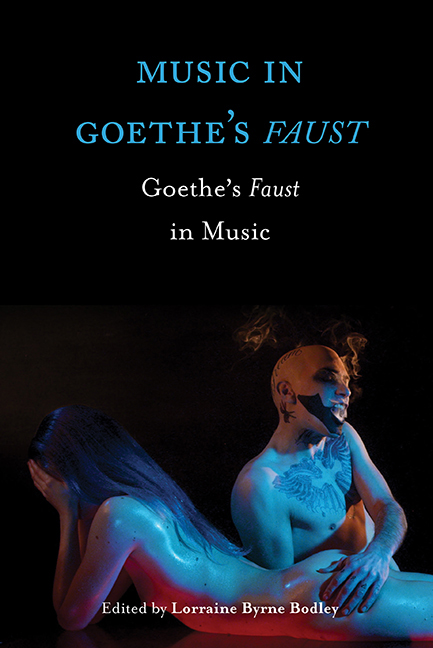Book contents
- Frontmatter
- Dedication
- Contents
- List of Illustrations
- Contributors
- Acknowledgements
- Abbreviations Used in the Notes
- Introduction. Rhapsody and Rebuke: Goethe's Faust in Music
- Part I Goethe's Faust: Content and Context
- Part II Legacies: Goethe's Faust in the Nineteenth Century
- Part III Topographies: Stagings and Critical Reception
- 12 Operatic Translation and Adaptation: Gounod's Faust, with a Tribute to Ken Russell
- 13 ‘Adapters, Falsifiers and Profiteers’: Staging La Damnation de Faust in Monte Carlo and Paris, 1893–1903
- 14 Faust in the Trenches: Busoni's Doktor Faust
- Part IV New Directions: Recent Productions and Appropriations
- Select Bibliography
- Index
14 - Faust in the Trenches: Busoni's Doktor Faust
from Part III - Topographies: Stagings and Critical Reception
Published online by Cambridge University Press: 30 August 2017
- Frontmatter
- Dedication
- Contents
- List of Illustrations
- Contributors
- Acknowledgements
- Abbreviations Used in the Notes
- Introduction. Rhapsody and Rebuke: Goethe's Faust in Music
- Part I Goethe's Faust: Content and Context
- Part II Legacies: Goethe's Faust in the Nineteenth Century
- Part III Topographies: Stagings and Critical Reception
- 12 Operatic Translation and Adaptation: Gounod's Faust, with a Tribute to Ken Russell
- 13 ‘Adapters, Falsifiers and Profiteers’: Staging La Damnation de Faust in Monte Carlo and Paris, 1893–1903
- 14 Faust in the Trenches: Busoni's Doktor Faust
- Part IV New Directions: Recent Productions and Appropriations
- Select Bibliography
- Index
Summary
The idea of a Faustian project was something that Ferruccio Busoni (1866– 1924) contemplated throughout his entire career, either directly or via what he considered alternative Faustian figures, such as Leonardo da Vinci or Don Juan; and while the actual composition of the opera Doktor Faust occupied him from 1916 until his death, many of his compositions prior to this time are directly related to the Faust project. Doktor Faust not only codifies many aspects of Busoni's theory, but it also stands as a highly individual treatment of the Faust legend deeply rooted in the traumatic era in which it was formed. It is therefore central to any consideration not only of Busoni's music but also of his theoretical ideas and his importance in the transition to modernism in the early twentieth century.
The early years of the twentieth century saw Busoni rethinking his aesthetic position, outlined in his Entwurf einer neuen Ästhetik der Tonkunst [Sketch of a new aesthetic of music], the first version of which was published in 1907. The book is indicative of Busoni's new-found freedom from nineteenth-century Germanic musical thinking and marks the first step towards his formulation of what he termed ‘Junge Klassizität’ [Young Classicism] in contrast to the overripe romanticism of many of his contemporaries. The ideas were developed further for a substantially revised version, published at Rainer Maria Rilke's suggestion in 1916, and continued to be refined in later essays, including his preface to the score of Doktor Faust. Busoni concluded Entwurf einer neuen Ästhetik by quoting in full section 255 of Nietzsche's Jenseits von Gut und Böse [Beyond Good and Evil], which outlines the necessity for rejection of the dominant Wagnerian cultural ideology:
Ein solcher Südländer, nicht der Abkunft, sondern dem Glauben nach, muß, falls er von der Zukunft der Musik träumt, auch von einer Erlösung der Musik vom Norden träumen und das Vorspiel einer tieferen, mächtigeren, vielleicht böseren und geheimnissvolleren Musik in seinen Ohren haben, einer überdeutschen Musik, welche vor dem Anblick des blauen wollüstigen Meers und der mittelländischen Himmels-Helle nicht verklingt, vergilbt, verblaßt, wie es alle deutsche Musik thut.
- Type
- Chapter
- Information
- Music in Goethe's FaustGoethe's Faust in Music, pp. 230 - 242Publisher: Boydell & BrewerPrint publication year: 2017

